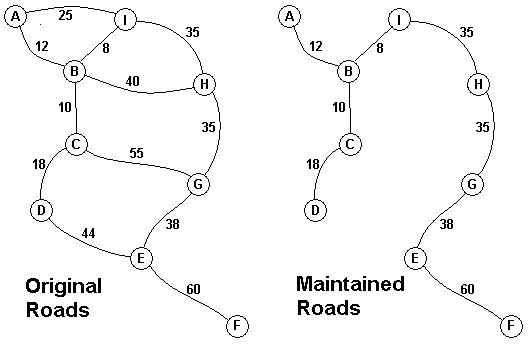Description

The Head Elder of the tropical island of Lagrishan has a problem. A burst of foreign aid money was spent on extra roads between villages some years ago. But the jungle overtakes roads relentlessly, so the large road network is too expensive to maintain. The Council of Elders must choose to stop maintaining some roads. The map above on the left shows all the roads in use now and the cost in aacms per month to maintain them. Of course there needs to be some way to get between all the villages on maintained roads, even if the route is not as short as before. The Chief Elder would like to tell the Council of Elders what would be the smallest amount they could spend in aacms per month to maintain roads that would connect all the villages. The villages are labeled A through I in the maps above. The map on the right shows the roads that could be maintained most cheaply, for 216 aacms per month. Your task is to write a program that will solve such problems.
Input
The input consists of one to 100 data sets, followed by a final line containing only 0. Each data set starts with a line containing only a number n, which is the number of villages, 1 < n < 27, and the villages are labeled with the first n letters of the alphabet, capitalized. Each data set is completed with n-1 lines that start with village labels in alphabetical order. There is no line for the last village. Each line for a village starts with the village label followed by a number, k, of roads from this village to villages with labels later in the alphabet. If k is greater than 0, the line continues with data for each of the k roads. The data for each road is the village label for the other end of the road followed by the monthly maintenance cost in aacms for the road. Maintenance costs will be positive integers less than 100. All data fields in the row are separated by single blanks. The road network will always allow travel between all the villages. The network will never have more than 75 roads. No village will have more than 15 roads going to other villages (before or after in the alphabet). In the sample input below, the first data set goes with the map above.
Output
The output is one integer per line for each data set: the minimum cost in aacms per month to maintain a road system that connect all the villages. Caution: A brute force solution that examines every possible set of roads will not finish within the one minute time limit.
Sample Input
9
A 2 B 12 I 25
B 3 C 10 H 40 I 8
C 2 D 18 G 55
D 1 E 44
E 2 F 60 G 38
F 0
G 1 H 35
H 1 I 35
3
A 2 B 10 C 40
B 1 C 20
0
Sample Output
216
30
题解
题目的核心是:构造一棵最小生成树。我采用的是 Kruskal 算法来解决此问题。
定义如下结构体保存路线信息:
struct node {
char u, v;// 起点和终点
int cost;// 花费
} roads[MAX_ROADS];// 路线
int roads_num;
Kruskal 算法构造最小生成树的步骤如下:
- 初始化每个顶点为一棵树,根结点是自己
- 遍历所有边,找到花费最小的边
- 如果这条边的两点属于同一棵树,那么不用处理
- 如果这条边的两点属于不同的树,那么将这两棵树合并(修改一个根结点的父结点为另一个根结点)
- 重复第2步,直到所有顶点都属于同一棵树为止
对于此题而言,只需要在2.2中将花费加起来,最后的和就是最小花费。
C代码
/*********************************************************************
File: 1251 -- Jungle Roads
Result: Accepted
Memory: 340K
Time: 0MS
Language: GCC
Code Length: 2028B
Version: 1.3
From: https://www.cnblogs.com/wowpH/p/11908562.html
Author: wowpH
Date: 2019-11-22 15:18:59
*********************************************************************/
#include <stdio.h>
#include <stdlib.h>
#define MAX_N 26
#define MAX_ROADS 75
struct node {
char u, v;// 起点和终点
int cost;// 花费
} roads[MAX_ROADS];// 路线
int roads_num;
int father[MAX_N];// 父结点,用于并查集
void input_roads(int n);
int compare(const void* a, const void* b);
int kruskal();
void init();
int merge(int u, int v);
int find(int x);
int main(void) {
int n;// 村庄个数
while (scanf("%d", &n) != EOF && n > 0) {
input_roads(n);// 输入路线
// 按照花费升序排序
qsort(roads, roads_num, sizeof(struct node), compare);
printf("%d
", kruskal());// 输出最小花费
}
return 0;
}
void input_roads(int n) {
roads_num = 0;// 路线个数重置为0
char start, end;
int number, cost;
for (int i = 1; i < n; ++i) {
scanf(" %c %d", &start, &number);// 输入起点和终点个数
for (int j = 0; j < number; ++j) {
scanf(" %c %d", &end, &cost);// 输入终点和花费
roads[roads_num].u = start;
roads[roads_num].v = end;
roads[roads_num].cost = cost;
++roads_num;
}
}
}
int compare(const void* a, const void* b) {
return (*(struct node*)a).cost - (*(struct node*)b).cost;// 升序
}
int kruskal() {// 克鲁斯卡尔算法,并查集算法实现
init();// 初始化
int min_cost = 0;// 最小花费
int u, v;// 起点,终点
for (int i = 0; i < roads_num; ++i) {
u = roads[i].u - 'A';
v = roads[i].v - 'A';
if (merge(u, v) == 0) {// 合并成功,此路线属于最小生成树
min_cost += roads[i].cost;
}
}
return min_cost;
}
void init() {// 并查集的初始化
for (int i = 0; i < MAX_N; ++i) {// 初始化父结点为自己
father[i] = i;
}
}
int merge(int u, int v) {// 并查集的合并
u = find(u);
v = find(v);
if (u != v) {// 不属于同一个集合,可以合并
father[v] = u;// 合并
return 0;// 成功
}
return -1;
}
int find(int x) {// 并查集的查找父结点
if (father[x] != x) {
father[x] = find(father[x]);// 压缩路径
}
return father[x];
}
中文版:
我觉得这题就是考英文的。
有 n 个村庄,之间有一些道路,为了维护道路需要花费一些钱,现在打算放弃部分道路,只维护 n-1 条道路,问最小的花费是多少?
这不就是最小生成树的典型题目吗?用 Prim 算法或者 Kruskal 算法即可。
限制条件:
- 1 < n < 27
- 1 <= 道路条数 <= 100
题目链接:http://poj.org/problem?id=1251
参考:Kruskal算法
原文链接:https://www.cnblogs.com/wowpH/p/11908562.html